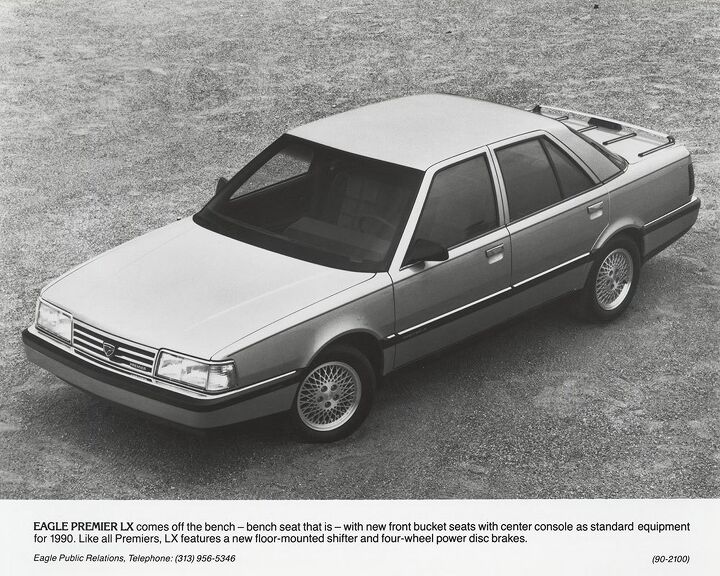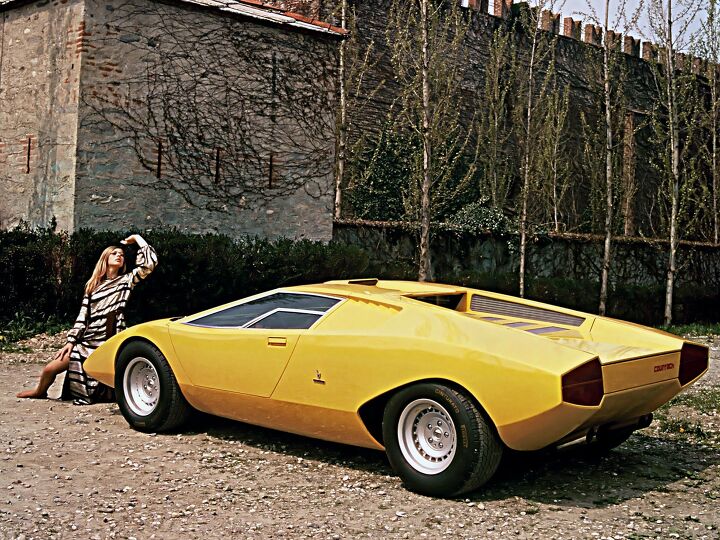#Giugiaro
Junkyard Find: 2000 Daewoo Lanos Sedan
Of all the far-flung outposts of the sprawling GM Empire, Daewoo produced some of the best stories. Today's Junkyard Find is an example of one of the three car models sold with Daewoo badging during the company's brief attempt to establish a toehold under its own name in North America.
Rare Rides Icons: The Abandoned Bugatti EB 112, a Super Sedan
Power, luxury, exclusivity, and grand touring driving enjoyment. The Bugatti EB112 promised all those adjectives in spades were it ever actually produced. But it was born at a very difficult time in the company’s history, and the super sedan never made it beyond the concept stage.
However, due to some interesting timing at the company level, the EB112 was not just a one-off concept. In fact, there are three in existence.
Rare Rides: The 1987 Hyundai Stellar, Korean Midsize and Ford Cousin
The Rare Rides series has featured just two Hyundai offerings in past entries, the affordable Pony that Canadians loved, and a Mitsubishi Precis that was a rebadge of the Excel. Today’s larger Rare Ride was sold alongside those two in places outside the United States. Meet Stellar.
Rare Rides: The Eagle Premier Story, Part VI (The End)
Today we wrap up our Rare Rides series on the orphan Eagle Premier (other five parts here), and discuss the boxy sedan’s important legacy at Chrysler.
Rare Rides: The Eagle Premier Story, Part V
The fifth entry in our Rare Rides series on the Eagle Premier brings us to 1988. The Premier was newly on sale after a delayed introduction, and the company building it was not the same company that spent years designing it.
Chrysler was in charge of the Premier’s fate.
Rare Rides: The Eagle Premier Story, Part IV
Today is the fourth installment in our Eagle Premier series. Parts I, II, and III brought us through late 1987 when the Premier finally entered production, albeit well behind schedule.
The Renault group’s high profile chairman had been assassinated in fall 1986 by French extremists, and the company’s new chair, Raymond Lévy, was experiencing pressure from all sides.
Rare Rides: The Eagle Premier Story, Part III
We continue our coverage today of the Eagle Premier from over 30 years ago. Parts I and II detailed the inception of the AMC-Renault joint project, and the technical aspects of what was a pretty advanced (or quirky) family sedan.
The time had come to put this all-new AMC offering on sale, but Premier arrived alongside some very unfortunate historical circumstances.
Rare Rides: The Eagle Premier Story, Part II
Part I of The Eagle Premier Story covered the inception of the collaborative AMC-Renault X-58 project in 1982, and its front-drive full-size flagship goal. It was to be an all-new car to lead AMC’s North American offerings. In today’s installment, we’ll take a look at the stylish sedan’s technical details more closely.
Rare Rides: The Eagle Premier Story, Part I
Today’s Rare Ride combined Italian design and French running gear in a full-size sedan marketed under an all-new brand: Eagle.
It’s time for the Eagle Premier story.
Rare Rides: An Elegant 1966 ASA 411 Berlinetta, Founded by Ferrari
A short-lived Italian experiment, the ASA brand was created by Enzo Ferrari himself. Think of it as a stylish Sixties Scion, if you will.
Rare Rides: Ferrari-Powered 1991 Lancia Thema 8.32, the Superior Sister of Saab and Alfa Romeo
It would be understandable if the Lancia Thema you see above put you immediately in mind of a Rare Ride from a few days ago, the gold-plated DeLorean DMC-12. While that car had an entirely different purpose from the Lancia you see before you, the two did have a couple of things in common. Both were designed by Italian legend Giorgetto Giugiaro. And like the DeLorean, the Lancia also suffered (in normal trims) with the same Peugeot-Renault-Volvo V6 engine that made Eagle Premier owners miserable.
But that’s where the similarities end. Because today’s Thema sheds its multinational, mediocre V6 power for some purebred Ferrari horses. And you don’t even have to do the import paperwork.
Volkswagen's Other Karmann Ghia: the Type 34
The Karmann Ghia is familiar to most automotive enthusiasts as a styling exercise intended to turn the Volkswagen Beetle into a slinky “sportscar” using pedestrian internals. The resulting Type 1 Ghia debuted way back in 1955 and added some (more) Porsche styling to the family sedan. Assembled by Karmann in Osnabrück, Germany, with styling from Carrozzeria Ghia in Turin, Italy, the curvy two-door offered little performance, but much style, compared to its stablemates.
However, the Type 1 Karmann Ghia wasn’t the only car to bear that German-Italian nameplate.
QOTD: When Will the Crossover Call It Quits?
As we bring you one Question of the Day each weekday, we figured getting someone from TTAC’s commentariat to ask questions of the same commentariat above the fold would add a dose of flavor. That flavor comes from Ohio, and its name is CoreyDL. Welcome him to the headlines and bylines.
It’s entirely likely in 2016 that you or someone you’re very close to own one or more crossovers. The CUV is as prevalent in the North American landscape these days as the midsize sedan was in about 1988. But as with the body-on-frame SUV which came before, and the all-American wood-sided family wagon before that, the party can’t last forever.
Safety groups want pedestrians to giggle like the Pillsbury Dough Boy when struck by two-ton metallic death machines, necessitating ever softer edges. Stricter fuel regulations push the roofs lower for the sake of aerodynamics, shrinking space for people and cargo. Designers who don’t shower very often show us shapes inspired by used bars of soap.
How long can this go on before the party’s over, and the CUV isn’t the cool kid any more?
Wedge Wonders - the Influence of the Angular Era in Automotive Design
Though it may seem hard to believe, we’re only a month away from celebrating the 50th anniversary of the start of the Wedge Era in automotive designs.
To those of us who still think of the Countach as a sharp enough design to be considered cutting edge, this is a sad reality. Yet the prototype of what would become the 1980s poster child was first shown in a hard-to-conceptualize 1971.
The influence of the angle extended far beyond the Countach in the 1980s. It also started before the scissored doors opened on the stand in Geneva in 1971 and was seen in many more marques than just those wearing the Raging Bull. Even more impressive than its age is the reach of these designs, some of which are still being refined today. So, let’s take a look at some of the interesting and influential doorstop shapes and where they later found a home.
Strange Bedfellows: A History of Unexpected Automotive Collaborations
It should come as no surprise that some of the most iconic automobile designs have interesting associations in their geneses. Where those associations come from, though, can sometimes be surprising, as companies leapfrog the globe trying to find the talent, technical expertise, and productive capacity to build a new or unique model.
These stories seem to pop up more often when there’s a shift in a company’s priorities or an attempted to redefine its direction or mission. Large organizations can be slow to adjust to these changes, and so often these major manufacturers turned to small teams to produce what have often become standout models from already legendary lineups.
Often, but not always, as we see in this montage of odd couples.






























Recent Comments